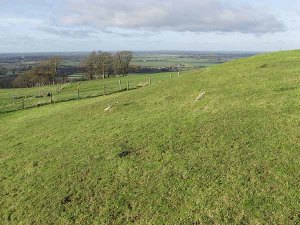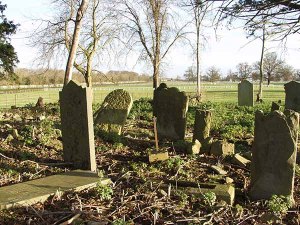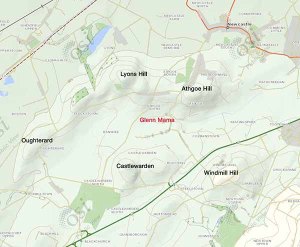THE IDENTIFICATION OF THE BATTLEFIELD OF GLENN MÁMA AD 1000
By JOSEPH H LLOYD, MRIA
Published in the Journal of the Kildare Archaeological Society, Vol. VII, No. 6 (July 1914)
Where was Glenn Máma?
The question I ask above is of considerable important not only from a topographical but even from a historical point of view; for the student, if he has a wrong idea of where a battle was fought, is no longer in possession of a fact of history, but of crass error.
Dr Henthron Todd’s Cogadh Gaedhel re Gallaibh pages cxliv-cxlvi, has been the means of leading a whole generation of scholars astray. As I wrote in another connexion: “The Late Rev Father Shearman, John O’Donovan, Dr James Henthern Todd, and later scholars, have all erroneously identified Glenn Máma with valley beside Dunlavin and Tornant in the County Wicklow. Father Shearman (in Cogadh Gaedhel re Gallaibh, as referred to above) even goes so far as to find traditions and identifications in the neighbourhood of Dunlavin forevery little incident and spot of the battle! All wrong! For the battle was fought elsewhere.”
The notes which follow here were put together years ago, and only now see the light of publicity. To some extent they have been anticipated by Mr Goddard Orpen, who, however, as the basis of his work had received from me a hint about the true position of Liamain.
Liamhain (using it in its modern form) is, undoubtedly, the present Lyons, a townland and parish in the barony of South Salt, County Kildare, or rather on the borders of Counties Dublin and Kildare. Here is situate Lord Cloncurry’s demesne and residence. Lyons was for a very long time in the possession of a branch of the Norman family of Aylmer, and is, consequently, as often mentioned in the Anglo-Irish records, as is its native prototype in the old Irish literature. The form in the “Book of Leinster” is Liamu, Liamuin, gen Liamna, a poem by Fulartach(?), deriving the name from Liamun(Liamuin), daughter of Dubthach Dubthaire, King of the Dési of Bregia (Rí Dése Breg). The older angicised forms are Lewan (Calendar of State Papers ad 1217), Leuan (ib 1223, 1224, 1225, 1228, 1230 and 1260); Lyons (?) (ib 1272); Lyons, (Ecclestastical Tax 1322); Liones, (Calendar of Carew MSS, 1535 and 1537); Castlelions on Petty’s map. The resemblance of Lewan, Leuan to latin leo, leonis may have helped the change to Lyons.
In ancient Ireland Lyons was a celebrated place, for it was one of the residences of the Kings of Leinster. Father Shearman, Dr Henthron Todd, O’Donovan, and O’Curry having noticed the occurrence of dún Liamhna – the dún of Liamhain, at once jumped to the conclusion that Dún Liamhna was another form of the name, and identified it with Dunlavin! But the Irish form of Dunlavin is in reality Dun Luadhaion, this and Liamhain occurring in the same Irish poem in different country-sides that identify each clearly. Thus, the former is mentioned along with its Mill (Miltown) and Rathsallagh, the latter with Newcastle, Castlewarden and Saggart.
23 May Féilire Oengus: Bás Conlaid, Ronchend din ainm Chondlaeid art us 7 is fris atberair Mochonda Daire. Conlaed .i. Cunnail Aed
1. Aed Cunnail nomen ejus 7 escop Cille Dara hé 7 coin allta aduatar hé ic Seechaib Condlaid I taeb Liamna a Muig Laigen .i. Conlaed mac Cormaic mic Aengusa mic Echach mic Sétna mif Fothaid mic Echach Laimdeirg mic Mesincorb. Prímcherd Brígde din Conlaed 7 is aire fuair bas lasna conaib .i. triall do Róim daróine dar sárugud mBrígde conid hí Brigit ro-ghuide dó-sam bás oband d’fagbáil & issed ón ro comaillead.
The death of Conlaed, Ronchend was Conlaed’s name at first, and it is he who is called Mochonda (My Conda) of Daire. Conlaed, that is, Cunnail Aed, that is, Aed Cunnail (friendly Aed) was his name, and he was Bishop of Kildare, and wolves devoured him at Sciaich Chondlaid beside Liamhain in Mag Laigen, that is, Condlaed son of Comrac son of Engus son of Eochaid Setna son of Fothad son of Eochaid Laimderg son of Mesincorb. Now Conlaed was Brigit’s chief artificer, and this is why he died by the wolves, viz, a journey he made to Rome in violation of Brigit’s command, so that Brigit prayed that he could die a sudden death on the way, and that is the very thing that was fulfilled.
The Scíaich Chondlaid (Conlaed’s whitethorns) dat Scechaib Condlaid, described above as being beside Liamain, is the present townland of Skeagh, beside Lyons, and bordering it on the north-east side:
Dec 9 Feilire Oengusa; in dí ingen .i. Mugna & Fedelm due filiae Allela meice Dunglaing ríg Laigen I gCill Ingen Aillela í n-iarthur Máige Liphi i. Mumain – Feidlimid I Cili Ingen n-Aililla a taib Liamna a n-iarthar Máige Liphi atáit. Aillela .i. mac Dunglaing ri Laighen .i. Liamain ni coir a cleith 7 a Cill Ingen Aililla í n-airther Maigi Lifi sunt simul. Mugain 7 Feidelem nomina. (Iarthar is probably a scribal error for airther).
The two daughters, that is, Mugna and Fedelm duae filiae of Ailell, son of Dunglang, King of Leinster, in Cell Imgen Aililla (the church of Ailill’s daughters) in the west of Mág Life, that is Mugain and Feidlimid in Cell Ingen Ailella, beside Liamhain in the west (?east) of Magh Liphi, are they. Of Ailill, viz, the son of Dunglang, King of Leinster, that is, Liamain, it is not right to conceal it, and in Cell Ingen Aililla in the east of Mág Lifi sunt simul. The names are Mugain and Feidelem.
From this we learn that there was an ancient church beside Liamhain in the west (?east) of Mágh Life, the latter being the old name for the north-eastern part of the County Kildare, and the level part of South Dublin. There is a “rebuilt” ruin in Lyons Demesne, which may very probably represent the site, and even contain some of the stones of the church of Mugain and Feidelm, the two daughters of Ailell.
The Martyrology of Donegal at December 9th, has a similar entry:-
Feidhlim, ógh, acus Mughain, ógh, dá inghin Ailealla mic Dunlaing, acus Cill na n-ingen, I n-iarthar Máighe Life I dtaobh Liamhna ainm a mbaile. Do shliocht Cathaoir Móir de Laighnibh dóibh.
Feidhlim, a virgin, and Mughain, a virgin the two daughters of Aileall, son of Dunglang, and the name of their residence is Cill na n-ingen (the church of the daughters), in the west (?east) of Mágh Life beside Liamhain. They were of the progeny of Cathaoir Mór of the Leinster people.
As the following extract show, Glenn Máma was also beside Liamhain:-
- Bamar adaig occ Liamain-
- Nír b’uathad boi ar ár n-iarair,
- Ligin I nGlind Máma I muig
- Ocus Ui chaoim Cheinnselaig
- ‘Gar gcoccur í nGlind Máma
- Do Laignib co ró-dána,
- Nin ro lamsatur taeb frinn
- Ó thánaic an lá láinfind
- We were a night at Liamain =
- Not few were those who were seeking us,
- The Leinstermen without in Glend Máma
- And the comely Ui Cheinnselaig
- When the Leinstermen were conspiring
- Against us too boldly in Glend Máma
- They did not dare to face us
- When the full fair day came
- – Muirchertach’s Circuit of Ireland
In the account of the Battle of Glenn Máma, AD 1000, as given in Cogadh Gaedhel re Gallaibh, pp 108-114, we read:-
Ro cuirit, dan. ba ocus muintera Laghen I n-Ascaill Gall ocus I n-Uibh Briuin Chualand ocus I n-Uibh Gabhra ocus I n-Uibh Donchadha, ocus tancatar Laghin ocus Gaill, sech na muinteraibh I conni mBriain ocus a comdháil .i. co Glend Máma.
Now the cows and families of the Leinster men were placed in Ascall Gall, and in Ui Briuin Chualand, and in Ui Gabhra, and in Ui Donchadha, and the Leinster men and the foreigners came beyond the families to meet Brian and to encounter him – viz, to Glend Máma.
Dr Todd in a note states that one MS has the reading “I n-Osgaill Gall I n-Uibh Briun Cualann 7 I n-Ibh Gabhra,” which would seem to make it (Ascaill Gall) a place in the territory of Ui Briuin Cualann, a district embracing the greater part of barony of Rathdown, and a portion of the north of the County Wicklow. It is clear from both extracts that Ascall Gall (lit the angle or district of the foreigners or Danes) was the Irish name for that portion of territory in the possession of the Danes of Dublin, ie the city and its immediate neighbourhood, which afterwards became “The County of the City of Dublin,” (Dublin with its franchises). The Danes themselves spelled it in their own language Dyflinnarskiri (=”Dublinshire”). Ui Briuin Chualann bordered it on the south; to the west of this was probably situate Ui Ghabhra (= the eastern portion of the present barony of Uppercross?), and to the west of this again Ui Dunchada (the district through which the Dodder flows, or rather; perhaps, to the west of it). It is stated that the Danes and Leinster men came “beyond (in advance of) the families (of the Leinster men) to Glenn Máma, that is, after placing “the families” for safety in the Dublin territory and in the present baronies of Rathdown and Uppercross, these allies advanced further west beyond them into the barony of Newcastle, by which advance on the level ground south-westwards they were bound to arrive very soon beside the hill of Lyons.
In the Four Masters’ account of the event we find the following “prophecy”:.
- Ticfaidher go Glinn Máma –
- Ní ba huissce dar láma –
- Ibhait neich digh tondaigh
- Imom Cloich I gClaen Chongair.
- Mebhais ass an maidhm co mbuaidh
- Corri tar Calli fo thuaidh
- Co loiscfidher Áth Cliath cain
- Iar n-indredh for Laighenmhaigh.
- People will come to Glenn Máma –
- It will not be a mere laying of hands
- (lit= water over hands, an easy matter) –
- Persons will drink a deadly draught
- Around the Cloch (stone) in Claen
- Congair (the slope of the house)
- The rout will be routed forth with victory
- Until it reaches beyond Caille (?) northwards,
- And beautiful Ath Cliath (Dublin) will be burnt
- After an irruption over Laighenmhaigh (Leinster plain)
An Chloch (with preposition governing accusative, imon Cloich) may be the present Ardclogh (Ard na Cloiche, “the height or raised ground of Clogh”) beside Oughterard, near Lyons; it is a townland which has been extensively quarried for road purposes on account of the amount of stone it contains. One may doubt very much that Claen Congair could have survived to this day, yet, at the same time, it is remarkable that the very next townland to Ardclogh, on the west side of it, is called Clownings, a name of considerable resemblance, of which the older forms are Clonyngh (1 Phil and Mary), Clonyngs, Cloning alias Clonnings (Patent Jac 1). Whilst, however, there are undoubted instances of –ac- changing to –o- in old English spellings – eg Maen – Mone, now Moone, Taom (Taem) – Tom-, and of –o- becoming –y- eg Balkynglas, now Baltinglass, for Bealach Conglais – it seems impossible to explain a loss of the C-, and Clownings, therefore, should rather represent Cluainíní. Cáille (? Acc Cailli) may be the same place as Liscaillah, Liscailau, Liscailan – Lis Caille?), a small portion of the present Esker, near Lucan: “Grant of 2 acres of land of the K’s demesne called Licaillah, near the church of Esker (near and convenient to that church) to build thereon; to remain the Dean and his successors, canons of the church of Esker for ever,” Calendar of SP 1229 AD. Liscaillah would be situate due north-east of the battlefield, which, according to the poetry, quoted by the writer of Cogadh Gaedhel re Gallaibh, was the exact direction of the route of the Danes and Leinster men:-
- Rugsat meic na rígh búrach
- Tre chath na nGall co tnúthach
- Gur chuirseat cath Gall co cruaidh
- Tré chath na nGaoidheal sairtuaidh
- The sons of the kings made a charge
- Through the ranks of the foreigners eagerly
- And drove the ranks of the foreigners fiercely
- Through the ranks of the Gaoidhil north-eastwards
From this stanza we may gather that the Danes were first routed by the charge of Brian’s force, and then driven pell-mell amongst the Leinster men, and through the confusion thus created both were forced to flee north-eastwards towards Esker.
To return to the Four Masters’ account, Laighenmhagh is another name Mágh Life (=the north-east of County Kildare as I have previously stated, and much of the south of County Dublin).
It is now time to discover the whereabouts of Glenn Máma. Having carefully examined the ground, I may state confidently that there is only one glen that could be described in any way as being beside or even near Lyons. This is the dale enclosed between the ridge formed by the Hill of Lyons and Athgoe Hill on the one side, and Castlewarden Hill, Busty Hill and Windmill Hill on the other. It might be described as extending on the Kildare side to Oughterard – just below this, though a little further west, are situate Ardclogh and Clownings – and in the Dublin direction almost to Rathcoole. Athgoe Castle and Colmanstown Castle, both in ruins, are in this glen. There is also in a small piece of land known as Parkaree (Páirc a Ríogh, “the King’s field”?). Could this have been so named from Aralt mac Amhlaibh (Harold Son of Olaf), who was slain in the battle? Or could it have once contained that memorable yew-tree in which Maelmordha, King of Leinster; was hiding when captured by Murchadh? Either circumstance should be sufficient to explain the name, which, however, could just have easily have another origin, especially when one bears in mind that the place is beside a royal residence, to wit, Liamhain, and that Páirc a ‘fhraoich “the heather field” is also possible.






